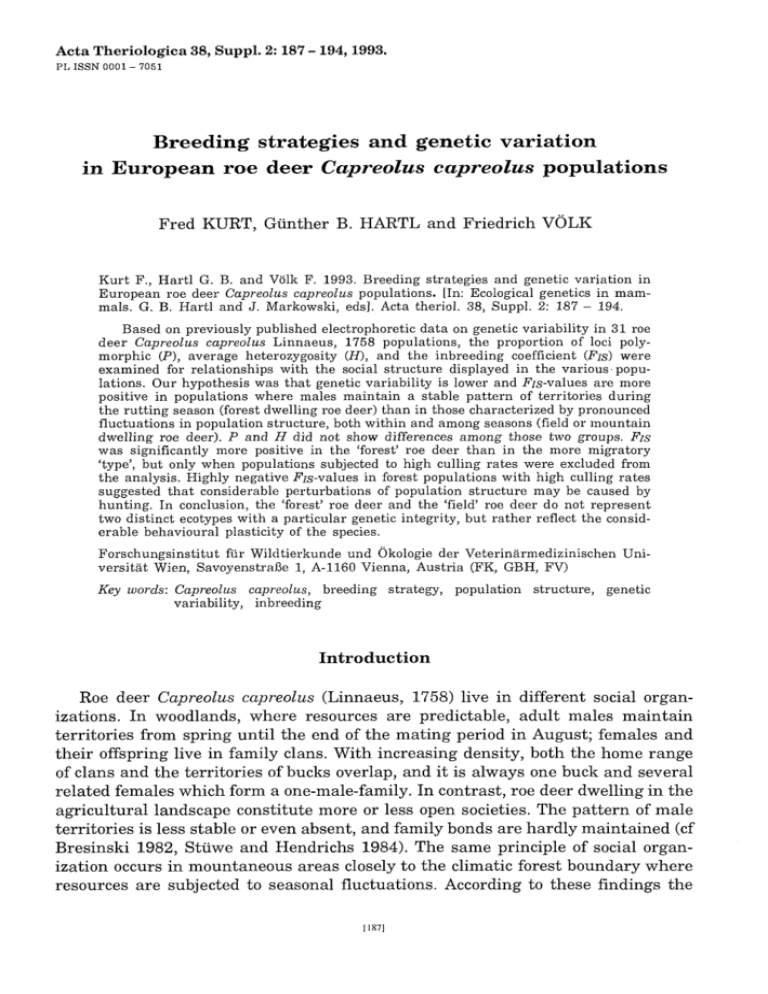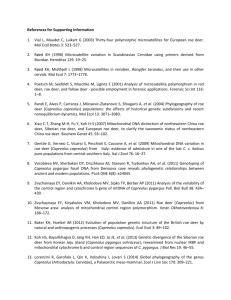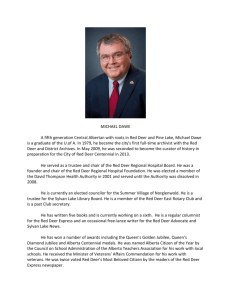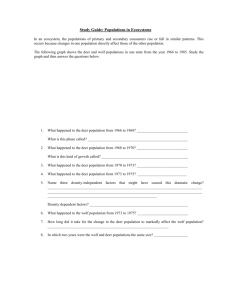Show publication content!
advertisement

Acta Theriologica 38, Suppl. 2:187 - 194,1993.
PL ISSN 0001 - 7051
Breeding strategies and genetic variation
in European roe deer Capreolus capreolus populations
Fred KURT, Günther B. HARTL and Friedrich VÖLK
Kurt P., Hartl G. B. and Volk F. 1993. Breeding strategies and genetic variation in
European roe deer Capreolus capreolus populations. [In: Ecological genetics in mam­
mals. G. B. Hartl and J. Markowski, eds], Acta theriol. 38, Suppl. 2: 187 - 194.
Based on previously published electrophoretic data on genetic variability in 31 roe
deer Capreolus capreolus Linnaeus, 1758 populations, the proportion of loci poly­
morphic (P), average heterozygosity (H), and the inbreeding coefficient (Fis) were
examined for relationships with the social structure displayed in the various-popu­
lations. Our hypothesis was that genetic variability is lower and F/s-values are more
positive in populations where males maintain a stable pattern of territories during
the rutting season (forest dwelling roe deer) than in those characterized by pronounced
fluctuations in population structure, both within and among seasons (field or mountain
dwelling roe deer). P and H did not show differences among those two groups. Fis
was significantly more positive in the ‘forest’ roe deer than in the more migratory
‘type’, but only when populations subjected to high culling rates were excluded from
the analysis. Highly negative Fis-values in forest populations with high culling rates
suggested that considerable perturbations of population structure may be caused by
hunting. In conclusion, the ‘forest’ roe deer and the ‘field’ roe deer do not represent
two distinct ecotypes with a particular genetic integrity, but rather reflect the consid­
erable behavioural plasticity of the species.
Forschungsinstitut für Wildtierkunde und Ökologie der Veterinärmedizinischen Uni­
versität Wien, Savoyenstraße 1, A-1160 Vienna, Austria (FK, GBH, FV)
Key words: Capreolus capreolus, breeding strategy,
variability, inbreeding
population
structure,
genetic
Introduction
Roe deer Capreolus capreolus (Linnaeus, 1758) live in different social organ­
izations. In woodlands, where resources are predictable, adult males maintain
territories from spring until the end of the mating period in August; females and
their offspring live in family clans. With increasing density, both the home range
of clans and the territories of bucks overlap, and it is always one buck and several
related females which form a one-male-family. In contrast, roe deer dwelling in the
agricultural landscape constitute more or less open societies. The pattern of male
territories is less stable or even absent, and family bonds are hardly maintained (cf
Bresinski 1982, Stiiwe and Hendrichs 1984). The same principle of social organ­
ization occurs in mountaneous areas closely to the climatic forest boundary where
resources are subjected to seasonal fluctuations. According to these findings the
188
P. Kurt et al.
social organization of roe deer can be predicted to a high degree by habitat structure
(Kurt 1968, 1991, Strandgaard 1972, Ellenberg 1978, Dzi^ciolowski 1979), and
differences in social organization are reflected by breeding strategies. In forest
dwelling roe deer only territorial males are rutting and females usually copulate
with only one and the same buck (Ellenberg 1978). Thus, depending on population
density, only about 20 per cent of all males contribute to the gene pool of the next
generation, which should result in a certain degree of inbreeding. The latter may
be increased by the maintenance of strict mother families, where contacts with
unrelated females are avoided. In contrast, the mating system in populations of field
and mountain dwelling roe deer is considered promiscous. Territorial behaviour is
less pronounced, there are no mother families, and females may copulate with a
number of different males (Strandgaard 1972, von Bayern 1975, Geiger 1983).
Consequently, a higher degree of panmixia is to be expected.
In the present study we examine migratory and territorial roe deer as to
differences in genetic variability and the inbreeding coefficient between both
groups. In particular, the existence of genetic peculiarities of the so called ‘field’
roe deer, which has been proposed to represent a distinct ecotype by Pielowski
Fig. 1. Roe deer populations included in the present study. ACH - Achenkirch, AUB - Auberg,
BAB - Babat, BMI - Bad Mitterndorf, BWA - Bregenzer Wald, GRO - Grosuplje, GWA - Großes
Walsertal, LAS - Lassee, MAL - Maria Alm, MEL - Melk, MON - Montafon, OEC - Öcsöd,
OLT - Olten, PIT - Pitvaros, PRA - Prättigau, PYH - Pyhra, SAN - St. Anton/J., SGA - St. Gallen,
SIT - Sitno, SOB - Soboth, SOL - Solothurn, STA - Stainz, TRA - Traun, VN - Northern Vosges,
WEI - Weiz, r l-r 5 - Bulgarian populations.
Breeding strategies and genetic variation in roe deer
189
(1977), and the genetic consequences of a high culling rate, disturbing a well
established system of territories in forest dwelling roe deer are addressed.
Material and methods
Our study is based on data on allozyme variation gathered from 31 European roe deer populations
by Hartl et al. (1991, 1993) and Gmeiner (1993) - see Fig. 1. Samples were divided into two groups
(territorial and migratory roe deer, see Table 1) according to habitat structure. Roe bucks are
territorial in forest habitats. These are defined as areas with more than 30 per cent o f woody
vegetation, which may be interspersed with meadows and groups of small fields with high crop
diversity. Roe deer are expected to be migratory in sub-alpine and/or alpine habitats as well as in
large, monotonous agricultural areas with less than 30 per cent of woodland.
Values of polymorphism (P, 99 per cent criterion), expected {He) and observed (H0) average
heterozygosity were taken from the papers cited above. The inbreeding coefficient (Fis) was calculated
according to Hartl (1988). in cases where a previous sample covered too large an area, we recalculated
indices of genetic variation and the inbreeding coefficient for a geographically more homogeneous
subsample (indicated by asterisks in Table 1). This seemed necessary to us, because estimates of Fis
may be influenced not only by the breeding structure of a population but also by geographic sub­
division occurring within a sampling area. Differences of P, He, and Fis between territorial and
migratory roe deer won; examined for statistical significance by means of the Mann-Whitney [/-test.
Results
Values of P, II,-, and Fis for all samples are listed in Table 1. He showed no
difference between territorial and migratory roe deer whereas there was a tend­
ency for / ’-values of being lower in the migratory group (p = 0.058). When all
samples were considered, a difference in Fis between territorial and migratory
roe deer barely failed to be statistically significant (p = 0.055). However, when
populations submitted to a high culling rate were excluded from the comparison,
a difference in Fis between both groups was statistically significant at p < 0.001.
Thereby ifys-values were largely positive in territorial and largely negative in
migratory roe deer (see Table 1).
Discussion
The results obtained in the present study support our hypothesis that inbreeding should be more pronounced in forest than in field or mountain dwelling
roe deer. However, this result became statistically significant only when samples
from populations submitted to a high culling rate were excluded from the analysis.
It is obvious from Table 1 that the culling rate is strongly associated with the
unexpected occurrence of highly negative ifys-values in some samples of the
territorial group, which may be explained in the following way. Fourty years ago
central European hunters were interested in raising the density of roe deer
populations, which had been strongly reduced by poaching during and immediately
after World War II. The number of individuals killed in the course of regular
F. Kurt et al.
190
Table 1. Inbreeding coefficients (Fis) in territorial and migratory roe deer, n - sample size, sources:
1 - Hartl et al. (1993), 2 - Hartl et al. (1991), 3 - Gmeiner (1993), * - subsample of GWA, **
subsamples of SGA, *** - subsample of PRA (see Hartl et al. 1991), **** - population with high
culling rate. P and He are given in per cent.
Territorial (n)
Fis
(JP.He)
Migratory (n)
Fis
(P, He)
Bulgaria r4x(23)
0.108
(17.5, 6.5)
Bulgaria r2x(21)
0.030
(17.5, 6.7)
Bregenzer Wald2(16)
0.074
(15.0, 5.4)
Lassee2(16)
0.023
(15.0, 4.3)
St. Anton/J.2(48)
0.051
(17.5, 5.9)
Achenkirch1(35)
0.0
(20.0, 4.5)
Bulgaria r5*(17)
0.048
(17.5, 6.9)
Melk2(16)****
-0.009
(15.0, 3.4)
Grosuplje1(19)
0.048
(17.5, 6.2)
Bulgaria r l 1(33)
-0.016
(17.5, 6.2)
Feldkirch2(17)*
0.047
(15.0, 4.2)
Bulgaria r31(27)
-0.016
(17.5, 6.4)
Schaenis2(12)**
0.030
(17.5, 3.9)
Pitvaros2(26)
-0.023
(15.0, 4.4)
Sitno1(16)
0.018
(17.5, 5.7)
Montafon2(20)
-0.035
(17.5, 5.8)
Sonnhalb2(10)**
0.004
(17.5, 4.8)
Bad Mitterndorfa(19)****
-0.036
(15.0, 5.6)
Northern Vosges1(36)
-0.02 4
(17.5, 4.1)
Babat2(8)
-0.051
(12.5, 3.9)
Pyhra2(23)****
-0.048
(17.5, 4.2)
01ten3(14)
-0.052
(15.0, 3.8)
Soboth2(12)****
-0.049
(17.5, 8.1)
Prättigau2(22)***
-0.066
(17.5, 6.1)
Auberg2(9)****
-0.128
(17.5, 4.7)
Öcsöd2(7)
-0.067
(12.5, 3.0)
Weiz2(14)****
-0.139
Traun2(12)****
(12.5, 3.6)
Stainz2(30)****
-0.155
(17.5, 5.8)
-0.087
(15.0, 4.6)
Maria Alm2( l l )
-0.188
(15.0, 6.4)
Solothurn2(25)
-0.408
(15.0, 4.9)
hunting (until the sixties predominately bucks) increased continuously, but hardly
exceeded the compensatory mortality until the seventies. During that time rather
stable patterns of territories with increasing genetic differentiation among family
Breeding strategies and genetic variation in roe deer
191
clans could establish in suitable habitats. Due to more and more hunters re­
cognizing that the potential of roe deer for increasing population density had been
grossly underestimated, hunting plans were further changed in favour of a high
culling rate. By the end of the seventies, especially in several forest habitats the
annual hunting bag was in the range of annual population increase. In the eighties,
in some areas even a reduction of population density was achieved. The destruction
of family clans by culling also a considerable number of fawns and high ranking
old does led to alterations in the distribution of individuals among part of formerly
well separated social groups. Given the establishment of one or the other allele
at highly polymorphic loci in one or the other family clan, the above influence of
hunting inevitably should have caused an excess of observed heterozygosity.
Negative F/s-values in the ‘field’ roe deer probably also reflect the reshuffling of
temporarily separated ‘sub-gene pools’, but here this process is expected to occur
in a natural and periodical way.
Since the electrophoretic data used in the present study had not primarily
been collected for testing the hypothesis outlined in the present paper, it must
also be considered that estimates of Fis may be biased to some extent. Apart from
considerable differences in sample sizes, several of the sampling areas represent
transient habitats rather than being typical examples of a forest, field, or mountaneous habitat. Roe deer populations in such transient habitats display a transient
social organization. Adult males try to maintain territories in forest patches, while
females and juveniles tend to spread into the open, cultivated landscape, where
groups consist of both related and unrelated members.
From a socio-ecological perspective, adult males are more conservative than
females and their offspring (Strandgaard 1972, Geiger 1983, Turner 1983a). Due
to differences in structure among particular transient habitats it is difficult to
formulate explicite predictions as to Fis-values, which are sufficiently distinct from
those for territorial or migratory roe deer. Thus, in the present study samples
from transient habitats have been considered either ‘territorial’ or ‘migratory’ by
relaxing the criteria outlined in the material and methods section.
Concerning the question whether migratory roe deer from large agricultural
areas, described as a new ‘ecotype’ by Pielowski (1977), are genetically different
from forest dwelling roe deer, the following conclusions can be drawn from popula­
tion genetic data. In spite of differences in F/s between territorial and migratory
roe deer, the extent of genetic diversity (He - see Nei 1975) within populations is
the same. P-values in the migratory group are on the whole somewhat lower and
more heterogeneous than in the territorial group, but this is rather the result of
geographical differentiation (see Hartl et ol. 1991, 1993) than a consequence of
being migratory. Also the general presence of the same alleles and the very low
genetic distances observed by Hartl et at. (1993) do not support the assumption
of a particular genetic integrity of the ‘field ecotype’. As suggested by Hofmann et
al. (1988) and Markowski and Markowska (1988), the various morphological
differences are rather due to environmental influences in conjunction with a broad
192
P. Kurt et al.
reaction norm. Turner (1979, 1983b) studied time budgeting of individually
marked roe deer in a transient habitat and found that, dependent on the habitat
type, each individual displayed different behavioural patterns. Thus, also the
behaviour of roe deer reflects a high degree of adaptability of this species rather
than a genetically well separated 'field ecotype’ . Similar adaptability of behaviour
and social organization has been described in several other deer species, such as
the white-tailed deer Odocoileus virginianus, the sambar Cervus unicolor, the
fallow deer Dama dama as well as in several bovids, such as the water buffalo
Bubalus bubalis and a number of African species (Kummer and Kurt 1973, Estes
1974, Leuthold 1977, Hirth 1977, Kurt 1978, Apollonio 1989).
In view of these data it is questionable, whether the behaviour of ‘field’ roe
deer actually reflects a very recent process of adaptation in a rapidly changinglandscape as suggested by Pielowski (1977). Non-territoriality of adult males and
open social groups may have been always present in certain habitats. Pronounced
territoriality is a product of competition for resources and mating partners. It
occurs only when the costs of marking and defending a territory are lower than
the benefit obtained from living in discrete ranges, where intraspecific competition
is reduced to that among closely related individuals. Such systems operate only
in a habitat type where resources are abundant, permanently available and more
or less equally distributed. These criteria are found in forest habitats with suf­
ficient undergrowth, where territoriality increases the personal fitness of the
owner. In habitats with seasonally changing resource availability, such as alpine
areas, roe deer follow their resources according to seasons and stable patterns of
territories can hardly establish. Similar organization occurs in riverine forests
where resources are not predictable due to irregular inundations (Kurt 1991). In
both habitats, breeding strategies are essentially the same as in ‘field’ roe deer
with differences occurring only as to group size. The formation of large groups is
an antipredator strategy in open areas with little cover (Eisenberg 1966) and not
a particular breeding strategy. The ONF (outbreeding non-territorial fusion-fission
system) strategy as displayed by ‘field’ roe deer probably occurred always in certain
habitat types next to the ITO (inbreeding territorial one male family system)
strategy. This assumption is supported by population genetic data.
The model of different social organizations of roe deer as discussed by Kurt
(1991) clearly shows that in forest dwelling roe deer there is the tendency of an
increasing population density to be accompanied by the formation of closer inbreeding groups. Thus, our results might also provide some explanation for the
observation of several researchers that with an increase in population density, in
the ‘forest’ roe deer the sex ratio of new born fawns becomes biased towards males.
This phenomenon and its sociobiological significance has been discussed at length
(Kurt 1968, Ellenberg 1978), but never under a genetical aspect. If inbreeding
increases with density as well, the male surplus could be due to sex ratio de­
pression as described by Senner (1980).
Breeding strategies and genetic variation in roe deer
193
References
Apollonio M. 1989. Lekking in fallow deer: just a matter of density? Ethol. Ecol. Evol. 1: 291 - 294.
Bayern A. von and Bayern J. von 1975. Über Rehe in einem steirischen Gebirgsrevier. BLV, München:
1 - 205.
Bresiński W. 1982. Grouping tendencies in roe deer under agrocenosis conditions. Acta theriol. 27:
427 - 447.
Dzięciołowski R. 1979. Structure and spatial organization o f deer populations. Acta theriol. 24: 3 - 21.
Eisenberg J. F. 1966. The social organizations of mammals. Kükenthals Handbuch der Zoologie
10: 1 - 92.
Ellenberg H. 1978. Zur Populationsökologie des Rehes (Capreolus capreolus L., Ceruidae) in Mittel­
europa. Spixiana, Suppl. 2: 1 - 212.
Estes R. D. 1974. Social organization of the African Bovidae, [In: The behaviour of ungulates
and its relation to management. V. Geist and F. Walther, eds]. IUCN Publications, New Series 24:
165 - 202.
Geiger C. 1983. Zur sozialen Organisation von Rehen in einer Übergangslandschaft zwischen Wald
und Ackergebiet. [In: Das Rehprojekt von Staffelbach und Zizers, C. Mertens und D. C. Turner,
eds]. Ethologie und Wildforschung, Universität Zürich: 176 - 191.
Gmeiner C. 1993. Genetische Diversität und ihre Einflußfaktoren beim Reh (Capreolus capreolus,
Cervidae), M. Sc. thesis, University of Vienna.
Hartl D. L. 1988. A primer of population genetics. Sinauer Associates, Sunderland, Massachusetts:
1 - 305.
Hartl G. B., Markov G., Rubin A., Findo S., Lang G. and Willing R. 1993. Allozyme diversity within
and among populations of three ungulate species (Cervus elaphus, Capreolus capreolus, Sus
scrofa) of Southeastern and Central Europe. Z. Säugetierk. (in press)
Hartl G. B., Reimoser F., Willing R. and Koller J. 1991. Genetic variability and differentiation in roe
deer (Capreolus capreolus L.) of Central Europe. Genetics, Selection, Evolution 23: 281 - 299.
Hirth D. H. 1977. Social behavior of white-tailed deer in relation to habitat. Wildl. Monogr. 53: 1 - 55.
Hofmann R. R., Saber A. S., Pielowski Z. and Fruziński B. 1988. Comparative morphological inves­
tigations of forest and field ecotypes of roe deer in Poland. Acta theriol. 33: 103 - 114.
Kummer H. and Kurt F. 1973. Umwelteinflüsse auf das Verhalten einiger Wildtierarten. [In: Wald
und Wild. H. Leibundgut, ed], Beiheft zur Zeitschrift des Schweizer Forstvereins 53: 82 - 89.
Kurt F. 1968. Zusammenhänge zwischen Verhalten und Fortpflanzungsleistung beim Reh (Capreolus
capreolus L.). Z. Jagdwiss. 14: 97 - 106.
Kurt F. 1978. Socio-ecological organization and aspects of management in South Asian deer. [In:
Threatened Deer. I. McTagger-Cowen and C. Holloway, eds], IUCN Publ.: 219 - 239.
Kurt F. 1991. Das Reh in der Kulturlandschaft - Sozialverhalten und Ökologie eines Anpassers. Paul
Parey, Hamburg und Berlin: 1 - 284.
Leuthold W. 1977. African ungulates. Springer Verlag, Berlin and New York: 1 - 307.
Markowski J. and Markowska M. 1988. Non-metrical variation in three populations of roe deer. Acta
theriol. 33: 519 - 536.
M. 1975. M olecular population genetics and evolution. Elsevier/North Holland,
Amsterdam: 1 - 288.
Pielowski Z. 1977. Das Feldreh - Wild der Zukunft in der Agrarlandschaft. Beitr. Jagd- u. Wildforsch.
Nei
10: 193 - 200.
Senner J. W. 1980. Inbreeding depression and the survival of zoo populations. [In: Conservation
biology - An evolutionary-ecological perspective. M. E. Soule and B. A. Wilcox, eds], Sinauer
Associates, Sunderland Massachusetts: 209 - 224.
194
P. Kurt et al.
Strandgaard H. 1972. The roe deer Capreolus capreolus population at Kalo and the factors regulating
its size. Danish Rev. Game Biol. 7: 1 - 205.
Stüwe M. and Hendrichs H. 1984. Organization of roe deer (Capreolus capreolus) in an open field
habitat. Z. Säugetierk. 49: 359 - 367.
Turner D. C. 1979. An analysis of time-budgeting by roe deer (Capreolus capreolus) in an agricultural
area. Behaviour 71: 246 - 290.
Turner D. C. 1983a. Nutzung eines Landwirtschaftsgebietes durch Rehe: Anpassung im Verhalten.
[In: Das Rehprojekt von Staffelbach und Zizers. C. Mertens und D. C. Turner, eds], Ethologie und
Wildforschung, Universität Zürich: 237 - 242.
Turner D. C. 1983b. Zeitbudgetierung bei Rehen in einem landwirtschaftlich intensiv genutzten
Gebiet. [In: Das Rehprojekt von Staffelbach und Zizers, C. Mertens und D. C. Turner, eds],
Ethologie und Wildforschung, Universität Zürich: 220 - 225.
Received 19 April 1993, accepted 1 June 1993.




